

An encyclopedia of Middle-earth and Numenor

|
|
|
|
|
|
|
|
|
|
|
|
|
|
| |
|
 |

An encyclopedia of Middle-earth and Numenor |
 |

After the Battle of Unnumbered Tears in 472 of the First Age, Easterlings occupied Hithlum and harrassed the Elves of Mithrim. The Elves fled to the Caves of Androth led by Annael, who was the foster-father of the infant Tuor. Tuor's father was Huor, a Man of Dor-lomin who had died in the battle. His mother Rian left Tuor in the care of Annael and went to find Huor's grave, where she laid down and died.
In the Caves of Androth, the Elves and Tuor had a hardscrabble existence. In 488, when Tuor was sixteen, Annael decided to lead his people to the Havens of Sirion. They made their way toward a secret passage out of Hithlum called the Gate of the Noldor, but they were attacked by a large force of Easterlings and Orcs. Annael and many other Elves escaped but Tuor was captured and enslaved by the Easterling chieftain Lorgan.
Tuor escaped from Lorgan in 491 and returned to the Caves of Androth where he lived for four years. From his hiding place, he attacked and killed many Easterlings, but the Easterlings feared to approach the caves where the Elves had dwelled.
In 495, Ulmo, Lord of Waters, caused a spring near the entrance of Tuor's cave to overflow and form a stream leading westward to the Gate of the Noldor. Tuor followed the stream out of Hithlum and eventually found the hidden realm of Gondolin.
Names &
Etymology:
The name Androth means "long
cave" in Sindarin from and meaning "long" and groth meaning
"delving, underground dwelling."
Sources:
The Silmarillion:
"Of Tuor and the Fall of Gondolin," p. 238; "Appendix - Elements in Quenya
and Sindarin Names," entries for an(d) and groth
Unfinished
Tales: "Of Tuor and His Coming to Gondolin," p. 18-20
The History
of Middle-earth, vol. XI, The War of the Jewels: "The Grey Annals,"
p. 91
Names &
Etymology:
Also spelled Brockenborings.
The name means "badgers' borings or tunnellings." The word brock
is an old word for "badger."
Sources:
Map of "A
Part of the Shire" by Christopher Tolkien
The Return
of the King: "The Grey Havens," p. 301
""Nomenclature
of The Lord of the Rings," entries for Brockhouse, Brockenbores,
and
Scary
Chambers of Fire (Sammath Naur) |
The
entrance to the Chambers of Fire
in the New Line film |
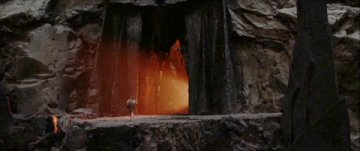 Cave
in Mount Doom where the One
Ring was forged and destroyed. The Chambers of Fire were in the upper
cone of Mount Doom on the eastern side. The entrance faced the Window of
the Eye in Barad-dur. Sauron's
Road led from Barad-dur up and around the slopes of Mount Doom to the
Chambers of Fire.
Cave
in Mount Doom where the One
Ring was forged and destroyed. The Chambers of Fire were in the upper
cone of Mount Doom on the eastern side. The entrance faced the Window of
the Eye in Barad-dur. Sauron's
Road led from Barad-dur up and around the slopes of Mount Doom to the
Chambers of Fire.
Inside was a long cave with a high roof. A short way from the entrance, the floor and walls of the cave were split by the great Crack of Doom. The Crack of Doom was a chasm that descended deep into the core of the volcano to the Fire of Doom. The fires in the Crack of Doom rose and fell, and there was a throbbing noise like engines from far below.
The Chambers of Fire were the heart of Sauron's realm, and his powers were at their height there. Sauron used the fires of the Crack of Doom as a source of power for his sorcery and as a great forge. Around 1600 of the Second Age, Sauron forged the One Ring in the Fire of Doom. The Ring could only be destroyed in the fires in which it was created.
On March 25, 3019 of the Third Age, Frodo Baggins came to the Chambers of Fire to cast the Ring into the Crack of Doom. He was followed by Sam Gamgee. Sam tried to use the Phial of Galadriel to illuminate the Chambers but the light was subdued by the strength of Sauron's power.
The Ring's power over Frodo had greatly increased as it neared the place of its making. At the edge of the Crack of Doom, Frodo was unable to bring himself to destroy the Ring and instead claimed it for himself. Then Frodo was attacked by Gollum who bit the Ring from Frodo's hand. Gollum lost his balance on the precipice and fell into the Fire of Doom. The Ring was consumed by the Fire and Sauron was defeated.
As Frodo and Sam escaped down the mountain, fire and lava erupted from the Crack of Doom and poured through the Chambers of Fire, spliting open the side of the mountain around the doorway.
Names &
Etymology:
The Sindarin name for the Chambers
of Fire was Sammath Naur from sammath the plural of sam
meaning "chamber" and naur meaning "fire."
The Crack of Doom was also called the Cracks of Doom.
Sources:
The Fellowship
of the Ring: "The Shadow of the Past," p. 70; "The Council of Elrond,"
p. 256, 280
The Return
of the King: "Mount Doom," p. 219, 222-25; "The Field of Cormallen,"
p. 228
The Silmarillion:
"Of the Rings of Power and the Third Age," p. 287-88, 292
The Orcs of Goblin-town made the secret entrance in the High Pass in 2941 of the Third Age after travellers stopped using another mountain pass where their main gate was. That same year, Thorin & Company took shelter from a storm in the Front Porch. Fili and Kili found the Front Porch and Gandalf thoroughly explored it but did not find any sign of the crack.
The crack opened after they fell asleep. The Dwarves and Bilbo Baggins were captured by Orcs and were brought before the Great Goblin. Gandalf avoided capture and slew the Great Goblin. The Dwarves escaped, though Bilbo became lost in the tunnels. He found the One Ring and encountered Gollum before he was able to rejoin the company.
Afterwards, Gandalf said he would try to find a Giant who would block up the Front Porch so travellers could use the High Pass again.
Sources:
The Hobbit:
"Over Hill and Under Hill," p. 69-74; "Out of the Frying-pan into the Fire,"
p. 105
Glittering CavesCaves in Rohan. The Glittering Caves were located behind Helm's Deep under the three peaks of the Thrihyrne in the northwestern arm of the White Mountains. Gimli called the Glittering Caves one of the marvels of the Northern World.The Glittering Caves extended deep under the mountains, with many passages, stairs, halls, and chambers. The floors were sandy and the ceilings were high, domed vaults. The walls were polished stone set with gems and crystals and veins of ore. Rising from the floors and hanging from the ceilings were columns and pinnacles of white, yellow, and rose. Fissures in the ceilings allowed air to circulate throughout the caverns. There were a number of still lakes and dark pools of water in the caves, and the Deeping-stream issued from the entrance. During the Battle of Helm's Deep on March 3-4, 3019 of the Third Age, many of the women, children, and elderly people of the Westfold took refuge in the Glittering Caves. Livestock and food were stored there as well. The entrance to the caves was behind the Deeping-wall in a narrow gorge that could be defended long against an onslaught. Some Orcs crept through a culvert in the Deeping-wall and entered the gorge but were killed or driven back by the defenders. Then the Deeping-wall was breached by an explosive device and the Enemy forces entered the Deep. Many of the Rohirrim including Eomer were driven back to the Glittering Caves, and with them was Gimli the Dwarf. Gimli was awed by what he saw and after the battle he described the wonders of the Glittering Caves to Legolas. The Elf agreed to accompany him to the Caves if Gimli would come with him to Fangorn Forest. On August 19, 3019, after the War of the Ring was over, Legolas kept his promise and visited the Glittering Caves and was left speechless by their beauty. Gimli decided to make his home in the caverns and became the Lord of the Glittering Caves. He brought a number of Dwarves from the Lonely Mountain to live there with him and they carefully tended the stone walls and opened new ways and chambers and hung lamps that filled the caverns with light. The Glittering Caves became one of the most important realms of the Dwarves at the beginning of the Fourth Age. Names &
Etymology:
Aglarond means "Glittering Caves." The word aglar means "glory, brilliance" and the word rond means "vaulted or arched roof" or a chamber or hall with such a roof. The name Glæmscrafu means "caves of radiance" in Anglo-Saxon, from glæm meaning "brilliant light, gleam, brilliance, brightness, splendor, beauty" and scrafu meaning "caves." Sources:
|
The
Glittering Caves by Paul Lasaine; Artwork from
the New Line film
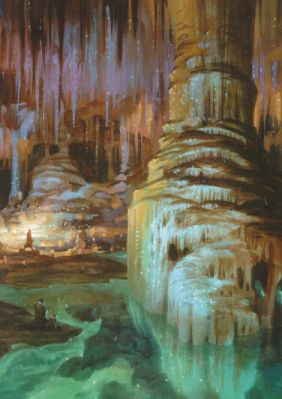 |
Henneth Annûn |
Matte
painting of Henneth Annun by Gus Hunter & Deak Farrand
for the New Line film |
 Refuge
behind a waterfall in Ithilien. Henneth Annun
was the name for both the falls and the refuge. The Rangers
of Ithilien used Henneth Annun as a base as they kept watch on Mordor.
Refuge
behind a waterfall in Ithilien. Henneth Annun
was the name for both the falls and the refuge. The Rangers
of Ithilien used Henneth Annun as a base as they kept watch on Mordor.
The waterfall of Henneth Annun was formed by a river that flowed westward across North Ithilien to the Anduin. The falls descended down a series of stone terraces and then dropped over a sheer cliff into the Forbidden Pool below.
In the sheer cliff face behind the falls was a large cave. The walls were rough and the roof was low and uneven. At the back of the cave was a recess that could be closed off with a curtain to make a private room.
The cave faced westward and the falls formed a window of water in front of it. At sunset it was an especially beautiful sight.
The level shafts of the setting sun behind beat upon it, and the red light was broken into many flickering beams of ever-changing colour. It was as if they stood at the window of some elven-tower, curtained with threaded jewels of silver and gold, and ruby, sapphire and amethyst, all kindled with an unconsuming fire.The only entrance into the cave was through a narrow passage that led to a flight of stone steps. At a landing, the steps branched into two flights. One wound upward to a ledge overlooking the falls and the other led to a hidden opening on the southern bank of the river above the falls.
The Two Towers: "The Window on the West," p. 282
The refuge of Henneth Annun was established in 2901 of the Third Age during the reign of Turin II, the Steward of Gondor. At that time Uruks from Mordor raided Ithilien and most of the inhabitants fled. Henneth Annun and other secret refuges were made for the use of the Rangers who remained on guard.
The falls of Henneth Annun originally flowed through the roof of the cave and out the archway. Workmen blocked the opening in the cave roof and changed the course of the river so that it fell in front of the cave's archway instead, concealing it from view.
Henneth Annun was the longest-manned refuge in Ithilien. During the War of the Ring, Faramir was the Captain of the Rangers of Ithilien who used Henneth Annun as their base of operations. Faramir brought Frodo Baggins and Sam Gamgee to Henneth Annun on March 7, 3019.
At Henneth Annun, Faramir learned that Frodo bore the One Ring and he rejected the temptation to seize it for himself. During the night, Gollum was found lurking by the Forbidden Pool, and though the penalty for trespassing near the secret refuge was death, Faramir spared the creature's life at Frodo's request.
The next morning on March 8, the Hobbits parted with Faramir and continued on their journey to Mordor. On March 9, Faramir left Henneth Annun to return to Minas Tirith.
Names &
Etymology:
Henneth Annun was also called theWindow
of the Sunset and the Window on the West. The waterfall was
sometimes called the Window-curtain or the Curtain.
The name Henneth Annûn means "window of the sunset" in Sindarin. The word henneth means "window" from the word hên meaning "eye." The word annûn means "sunset, west."
Sources:
The Two
Towers: "The Window on the West," p. 281-91; "The Forbidden Pool,"
passim; "Journey to the Cross-roads," p. 303-4
The Return
of the King: "The Siege of Gondor," p. 85
Appendix
A of The Lord of the Rings: "The Stewards," p. 335
The Silmarillion:
"Appendix - Elements in Quenya and Sindarin Names," entry for andune
The History
of Middle-earth, vol. V, The Lost Road and Other Writings: "The Etymologies,"
entry for KHEN-D-E
Paths of the Dead |
Map
of the Paths of the Dead
|
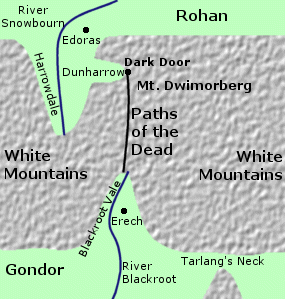 Haunted
passage under the White Mountains. The
Paths of the Dead began in the valley of Harrowdale
in Rohan on the northern side of the mountains
and ran underground to the Blackroot
Vale in Gondor on the southern side. The
Dead
who dwelled there were cursed never to rest until they fulfilled an ancient
oath they had broken.
Haunted
passage under the White Mountains. The
Paths of the Dead began in the valley of Harrowdale
in Rohan on the northern side of the mountains
and ran underground to the Blackroot
Vale in Gondor on the southern side. The
Dead
who dwelled there were cursed never to rest until they fulfilled an ancient
oath they had broken.
The entrance to the Paths of the Dead was in Dwimorberg, the Haunted Mountain. A path lined with ancient stones led from the stronghold of Dunharrow through the dark wood called the Dimholt to the root of the Dwimorberg. There a single stone marked the opening to a glen and beyond in a sheer wall of rock was the Dark Door.
Inside was a long, wide tunnel that led to a great chamber. There was a locked door in the chamber, beyond which was an evil temple hall. The tunnel continued to an arched gateway that opened onto the Blackroot Vale. The Blackroot River issued from the gateway and flowed southward through the valley and a road ran beside it. Down in the Blackroot Vale stood the Hill of Erech. Upon the hill was a great, round, black stone as tall as a Man. It was said that Isildur had brought the Stone of Erech from Numenor and had set it there.
The King of the Men of the Mountains swore allegiance to Isildur on the Stone after Gondor was founded. But when Isildur summoned them to fight Sauron at the end of the Second Age, they refused for they had once worshipped Sauron. Then Isildur cursed them and said that they would never rest until they fulfilled their oath to fight Sauron. The Oathbreakers fled and hid themselves under the mountains and there they remained for over 3,000 years.
The Dark Door leading to the Paths of the Dead was found by Brego of Rohan and his son Baldor as they explored the valley of Harrowdale seeking a refuge for their people. It is said that an ancient man was sitting before the door, and when Brego and Baldor tried to pass him, the old man said: "The way is shut. It was made by those who are Dead, and the Dead keep it, until the time comes." Baldor asked, "And when will that time be?" but the old man died without answering. (RotK, p. 71)
Baldor made a rash vow to walk the Paths of the Dead, and in 2570 of the Third Age he entered the Dark Door. He died clawing at the locked door in the great chamber and no one knew what had become of him for many centuries. No living Man dared to enter the Paths of the Dead again until Aragorn took that dark road during the War of the Ring.
Aragorn received a message from Elrond reminding him of a prophecy spoken by Malbeth the Seer long ago during the reign of King Arvedui of Arthedain (1964-1975). Malbeth had foretold that a time of great darkness would come when Isildur's heir would summon the Dead to fulfill their oath. Aragorn looked into the palantir and learned that a fleet of Corsairs allied with Sauron were intending to attack Minas Tirith from the South. He decided to take the Paths of the Dead and summon the Oathbreakers to the port of Pelargir to stop the Corsairs.
Aragorn entered the Paths of the Dead at dawn on March 8, 3019. With him went the Grey Company comprised of Halbarad and 30 Rangers of the North, Elrond's sons Elladan and Elrohir, and Legolas and Gimli. Aragorn's will was so strong that all found the courage to follow him.
As the Grey Company walked through the dark passage, the Dead gathered behind them. They came to the great chamber where they found Baldor's remains. Then Aragorn summoned the Dead to the Stone of Erech. The Grey Company emerged from the Paths of the Dead two hours before sunset. They rode through the Blackroot Vale with the Dead following behind and the people who lived in the valley fled in terror.
At midnight the Grey Company came to the Stone of Erech. Aragorn revealed himself as Isildur's heir and told the Oathbreakers that he would hold their oaths fulfilled if they would fight the servants of Sauron. The Dead followed Aragorn to Pelargir and on March 13 the Shadow Host swept over the Corsairs' ships. None could withstand their presence and the fleet was captured. Aragorn released the Dead to be at peace at last and they vanished like mist from the world of the living.
Names &
Etymology:
The Sindarin name for the Paths
of the Dead was Fui 'Ngorthrim. The word gorth may mean
"dead person." The ending rim means "host, great number." The meaning
of fui is unclear in this instance. It appears to be related to
fuin
meaning "gloom, darkness" so that Fui 'Ngorthrim could mean "dark
[paths] of the Dead" with the word "paths" implied. Tolkien apparently
originally named it Raith 'Ngorthrim - in which raith is
the plural of rath meaning "street" - but then changed it to
Fui
'Ngorthrim.
Sources:
The Return
of the King: "The Passing of the Grey Company," passim; "The Muster
of Rohan," p. 66-71; "The Last Debate," p. 150-53
Appendix
A of The Lord of the Rings: "The House of Eorl," p. 349
"The Rivers
and Beacon-hills of Gondor," by J.R.R. Tolkien, edited by Carl F. Hostetter,
commentary by Christopher Tolkien, in Vinyar Tengwar #42, July 2001,
p. 22 note 6 (on the locked door and Baldor's fate)
The Atlas
of Middle-earth by Karen Wynn Fonstad: Map of the White Mountains,
p. 88-89; Map of Dunharrow, p. 137
The Journeys
of Frodo by Barbara Strachey: Map #41 of Dunharrow; Map #45 of Aragorn
and the Grey Company
Gateway
to Sindarin by David Salo: p. 259 (gorth)
The Silmarillion:
"Appendix - Elements in Quenya and Sindarin Names," entries for fuin
and rim
The Lord
of the Rings: A Reader's Companion by Wayne G. Hammond and Christina
Scull: "The Passing of the Grey Company," p. 526
Shelob's Lair |
Top:
Frodo in Shelob's Lair in the New
Line film
Bottom: Basic layout of Shelob's Lair |
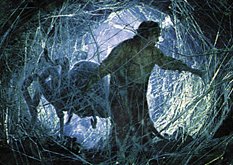 Tunnels
inhabited by the Great Spider Shelob.
Shelob's Lair was located high in the Mountains
of Shadow on the western border of Mordor.
The western entrance to the lair was in a cliff about a mile from the top
of the Stairs of Cirith
Ungol.
Tunnels
inhabited by the Great Spider Shelob.
Shelob's Lair was located high in the Mountains
of Shadow on the western border of Mordor.
The western entrance to the lair was in a cliff about a mile from the top
of the Stairs of Cirith
Ungol.
Inside Shelob's Lair, the main tunnel ran west to east. It was high and wide with smooth walls and a floor that sloped upwards. Cobwebs hung from the ceiling. There was a terrible smell in the tunnel and it was pitch dark.
Here the air was still, stagnant, heavy, and sound fell dead. They walked as it were in a black vapour wrought of veritable darkness itself that, as it was breathed, brought blindness not only to the eyes but to the mind, so that even the memory of colours and of forms and of any light faded out of thought. Night always had been, and always would be, and night was all.More passages branched off the main tunnel on either side. Deep inside Shelob's Lair, there was a large passage on the northern, or lefthand, side of the main tunnel. From this passage issued the worst stench as well as a sense of evil, because it led to the great round pit where Shelob dwelled.
The Two Towers: "Shelob's Lair," p. 326-27
Past this passage, the main tunnel continued eastward for a short distance and then forked into two branches. The branch on the left was blocked with a stone door with a small open transom above it. On the other side of the door was a passage called the Under-way that led to the Undergate on the lower level of the Tower of Cirith Ungol.
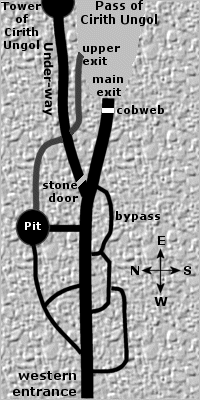 The
branch on the right led out to the Pass of Cirith Ungol.
The exit was blocked with a huge, incredibly strong cobweb. This main exit
was not the only exit from Shelob's Lair. The Great Spider had other secret
exits, including one that opened onto the Pass of Cirith Ungol just beyond
the main exit.
The
branch on the right led out to the Pass of Cirith Ungol.
The exit was blocked with a huge, incredibly strong cobweb. This main exit
was not the only exit from Shelob's Lair. The Great Spider had other secret
exits, including one that opened onto the Pass of Cirith Ungol just beyond
the main exit.
Shelob came to live in her Lair sometime before the year 1000 of the Second Age. How and when the main tunnel and the pit were made is not known, but some of the side passages - including the Under-way - were made by Orcs. The Orcs had to pass through Shelob's Lair on occasion since it was the quickest way between the Tower of Cirith Ungol and Minas Morgul in the Morgul Vale. They tried to avoid the Great Spider by using the side passages, but inevitably some were caught and eaten. Sauron also sometimes sent prisoners to Shelob's Lair to be hunted and devoured.
Gollum found Shelob's Lair around 2980 of the Third Age. Many years later, on March 12, 3019, he brought Frodo Baggins and Sam Gamgee to Shelob's Lair in hopes that he would be able to retrieve the One Ring after Shelob killed the Hobbits. Abandoned by Gollum, Frodo and Sam made their way eastward through the main tunnel and past the passage leading to Shelob's pit. When they came to the fork in the main tunnel, Shelob came up behind them, but Frodo drove her back with Sting and the Phial given to him by Galadriel.
The lefthand branch of the tunnel was blocked by the stone door, so the Hobbits went up the righthand branch until they came to the cobweb across the exit. Frodo used Sting to cut through the cobweb and ran out of Shelob's Lair, but Shelob came out of her secret upper exit and injected him with her poison while Sam was waylaid by Gollum. Sam wounded Shelob, and she retreated into her Lair where she may have died.
Sam believed Frodo to be dead and took the Ring from him, intending to continue the quest, but then Frodo was found by Shagrat and Gorbag. The Orcs took Frodo back into Shelob's Lair and down the Under-way to the gate in the lower level of the Tower of Cirith Ungol. Sam tried to follow them, but the gate was closed in his face. He retraced his steps out of Shelob's Lair and crossed the Pass of Cirith Ungol, approaching the Tower from the front to come to Frodo's rescue.
Names &
Etymology:
The Sindarin name of Shelob's Lair
was Torech Ungol, meaning "Spider's Hole." The word ungol
means "spider" from the Quenya ungwe meaning "gloom" and ungo
meaning "cloud, dark shadow." Ungoliant was the mother of Shelob and the
ancestor of all the Great Spiders. The word torech apparently means
"hole, lair," though its etymology is unclear.
Sources:
The Two
Towers: "The Black Gate Is Closed," p. 251; "The Forbidden Pool," p.
301 "The Stairs of Cirith Ungol," p. 318-20, 324-25; "Shelob's Lair," passim;
"The Choices of Master Samwise," passim
The Return
of the King: "The Tower of Cirith Ungol," p. 173-74
The History
of Middle-earth, vol. V, The Lost Road and Other Writings: "The Etymologies,"
entry for UNG
The History
of Middle-earth, vol. VIII, The War of the Ring: "Kirith Ungol," passim,
especially description and plan of Shelob's Lair, p. 200-201
The Witch-king established a camp at Andrath in late September 3018 of the Third Age with three other Nazgul as they hunted for Frodo Baggins, the Ring-bearer. From his base at Andrath, the Witch-king visited the Barrow-downs and roused the Barrow-wight who tried to trap Frodo in a tomb. On September 30, all Nine Nazgul assembled at Andrath and then pursued Frodo to Weathertop.
Names &
Etymology:
The name Andrath means "Long
Climb" in Sindarin from
an meaning "long" and rath meaning
"climb."
Sources:
Unfinished
Tales: "The History of Galadriel and Celeborn," p. 255 note 16; "The
Hunt for the Ring," p. 348; Index entry for Andrath
The Lord
of the Rings: A Reader's Companion by Wayne G. Hammond and Christina
Scull: "Fog of the Barrow-downs," p. 145; "A Knife in the Dark," p. 166
Names &
Etymology:
Also called the Haunted Pass.
Cirith
Gorgor means "haunted pass." The word cirith means "pass," from
kir meaning "cut, cleave." The word gorgor means "extreme horror,
haunting fear."
Sources:
The Two
Towers: "The Black Gate Is Closed," p. 244, 247
The Return
of the King: "The Black Gate Opens," p. 162-63, 167; "The Land of Shadow,"
p. 201; "Mount Doom," p. 210
The Silmarillion:
"Appendix - Elements in Quenya and Sindarin Names," entries for gor
and kir
The Lord
of the Rings: A Reader's Companion by Wayne G. Hammond and Christina
Scull: "Farewell to Lorien," p. 334-35
Cirith Ungol |
Cirith
Ungol by Alan Lee
|
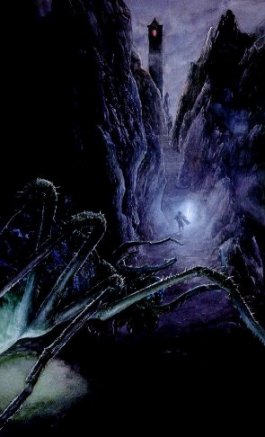 Pass
in the Mountains of Shadow on the
western border of Mordor. The Pass of Cirith
Ungol was high in the mountains, above the main pass through the Morgul
Vale which was called the
Morgul Pass. From the
west, the Pass of Cirith Ungol could be reached by climbing the Straight
Stair and the Winding
Stair on the northern side of the Morgul Vale and then going through
the tunnel of Shelob's Lair.
Pass
in the Mountains of Shadow on the
western border of Mordor. The Pass of Cirith
Ungol was high in the mountains, above the main pass through the Morgul
Vale which was called the
Morgul Pass. From the
west, the Pass of Cirith Ungol could be reached by climbing the Straight
Stair and the Winding
Stair on the northern side of the Morgul Vale and then going through
the tunnel of Shelob's Lair.
The Pass of Cirith Ungol was a high, narrow Cleft between two horns of rock. On the western side, the pass ran up a slope and then a flight of broad stone steps, narrowing as it neared the top of the Cleft. On the eastern side, there were more steps and a steep path leading down to the Tower of Cirith Ungol, which guarded the Pass.
The Tower of Cirith Ungol was built up against the eastern side of the northern horn of the Pass. The road that came down from the Pass ran along a precipe around the base of the Tower. The road then turned southwards and downwards to meet the Morgul-road that came over the Morgul Pass into Mordor.
In the early part of the Third Age, the Pass of Cirith Ungol was guarded by the Men of Gondor, who built the Tower there after Sauron's defeat in the War of the Last Alliance. But Gondor's vigilance grew lax, and after the Lord of the Nazgul returned to Mordor in 1980, he took control of the Tower. In the year 2000, the Nazgul came over the Pass of Cirith Ungol and besieged Minas Ithil, which was at that time still a stronghold of Gondor. The Nazgul captured the stronghold in 2002 and it became known as Minas Morgul.
The Pass of Cirith Ungol was used by Orcs travelling between the Tower of Cirith Ungol and Minas Morgul. It was a somewhat quicker route between the two strongholds than the Morgul Pass. However, it was more dangerous since it required passing through the tunnel where the Great Spider Shelob dwelled.
Sam Gamgee came to the top of the Pass of Cirith Ungol on March 13, 3019. He had taken the Ring from Frodo, whom he believed to be dead. A company of Orcs from the Tower led by Shagrat came up the pass from the other side, and Sam put on the Ring to avoid being seen. The Orcs found Frodo and took him to the Tower via the Under-way in Shelob's Lair. Sam was unable to follow them through the Undergate, so he returned to the Pass of Cirith Ungol on March 14 and crossed into Mordor.
Names &
Etymology:
Cirith Ungol means "Pass
of the Spider." The word cirith means "pass" from kir meaning
"cut, cleave." The word ungol means "spider" from the Quenya ungwe
meaning "gloom" and ungo meaning "cloud, dark shadow." Calling it
the Pass of Cirith Ungol is actually redundant, but useful in order
to distinguish the Pass from the Tower.
The Pass was originally called Cirith Dúath meaning "shadow cleft." The word dúath means "shadow" from dú meaning "night, dimness."
Also called the Cleft.
Sources:
The Two
Towers: "The Black Gate Is Closed," p. 251-52; "The Forbidden Pool,"
p. 300-301; "The Stairs of Cirith Ungol," p. 319-20; "Shelob's Lair," p.
332; "The Choices of Master Samwise," p. 342-44
The Return
of the King: "The Siege of Gondor," p. 85, 88-89; "The Tower of Cirith
Ungol," p. 174-76
The Silmarillion:
"Appendix - Elements in Quenya and Sindarin Names," entreis for du
and kir
Unfinished
Tales: "The Disaster of the Gladden Fields," p. 280 note 11
The History
of Middle-earth, vol. V, The Lost Road and Other Writings: "The Etymologies,"
entry for UNG
During the fall of Gondolin in 510 of the First Age, a group of survivors including Tuor, Idril, and Earendil climbed to the Eagles' Cleft. There they were ambused by Orcs and a Balrog. Glorfindel battled the Balrog and they both fell into the abyss to their deaths. The Orcs were slain or driven over the edge of the pass by Eagles, and the survivors were able to escape.
Thorondor retrieved Glorfindel's body. He was buried beside the pass under a mound of stones which became overgrown with grass and yellow flowers, and his grave remained there until the destruction of Beleriand during the War of Wrath and the end of the First Age. Glorfindel's spirit went to the Halls of Mandos and he later returned to Middle-earth.
Names &
Etymology:
The Eagles' Cleft was called
Cirith
Thoronath in Sindarin. The word cirith means "pass" and thoronath
means "eagles."
Sources:
The Silmarillion:
"Of Tuor and the Fall of Gondolin," p. 243; "Appendix - Elements in Quenya
and Sindarin Names," entries for kir and thoron
Gap of Rohan |
Map
of the Gap of Rohan
|
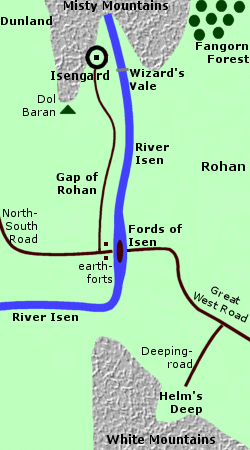 Passage
between the Misty Mountains and the
White
Mountains. The Gap of Rohan was an important route for travellers between
northern and southern Middle-earth. But the Gap also was also a vulnerable
point in the western defenses of
Rohan and Gondor,
and it was guarded by two great strongholds: Isengard
and Helm's Deep.
Passage
between the Misty Mountains and the
White
Mountains. The Gap of Rohan was an important route for travellers between
northern and southern Middle-earth. But the Gap also was also a vulnerable
point in the western defenses of
Rohan and Gondor,
and it was guarded by two great strongholds: Isengard
and Helm's Deep.
Rohan was east of the Gap that bore its name. Before Rohan was founded in 2510 of the Third Age, the land east of the Gap was Calenardhon, a province of Gondor. The passage was called the Gap of Calenardhon at that time. West of the Gap was the region of Enedwaith. Dunland was in Enedwaith at the foot of the Misty Mountains just north of the Gap of Rohan.
The Gap of Rohan was about 20 miles wide. On the southern side of the Gap was the northern spur of the White Mountains. Helm's Deep was on the eastern side of this spur, about 15 miles from the Gap. On the northern side of the Gap was the Wizard's Vale at the southern end of the Misty Mountains. Isengard was in the Wizard's Vale. Dol Baran was the last foothill of the Misty Mountains extending into the Gap.
The River Isen flowed from the Wizard's Vale south into the Gap of Rohan and then curved westward to the Sea. The river could be crossed at the Fords of Isen in the Gap. The Great West Road from Gondor and Rohan ran to the eastern bank of the Fords of Isen, and from the western bank continued the North-South Road to Eriador. A road branched north to Isengard on the west side of the Isen.
The Great West Road and the North-South Road together formed the Royal Road which had been built to enable travel between Gondor and Arnor. The two kingdoms were founded in 3320 of the Second Age. Isengard was built shortly thereafter to guard against an attack on Gondor through the Gap from the west. Aglarond - later known as Helm's Deep - was built in the Third Age during the reign of the Ship-kings (830-1149).
Gondor gave Calenardhon to the Rohirrim in 2510. Isengard remained nominally under Gondor's control, though the guard there decreased and the stronghold was left in the care of a local family who were partly of Dunlendish descent. Dunlendings migrated through the Gap into the Westfold of Rohan.
The Men of Dunland were driven back through the Gap during the reigns of the first three Kings of Rohan. The Dunlendings grew to hate the Rohirrim and posed a continual threat on Rohan's western border. In 2710, Dunlendings took over Isengard and began raiding the Westfold. King Deor of Rohan defeated the raiders but was unable to dislodge them from Isengard.
In 2758, the Dunlendings led by Wulf launched an invasion through the Gap of Rohan. Many Rohirrim were killed trying to defend the Fords of Isen. King Helm and the survivors were besieged in the stronghold that afterwards became known as Helm's Deep during the Long Winter of 2758-59. Wulf was defeated by Frealaf in the spring of 2759 and the Dunlendings were again driven back through the Gap.
That same year, Saruman was given permission to live at Isengard by the Steward of Gondor in hopes that his presence would help protect against another invasion through the Gap of Rohan. But Saruman became corrupted with a desire for power and he made an alliance with the Dunlendings against the Rohirrim.
Boromir passed through the Gap of Rohan on his way to Rivendell in the summer of 3018. But the Fellowship avoided the Gap of Rohan on their journey south because they did not want the One Ring to fall into Saruman's hands. Instead they passed through the Mines of Moria to get to the eastern side of the Misty Mountains.
Saruman meanwhile had closed the Gap of Rohan to the Rohirrim. In early 3019, the Battles of the Fords of Isen were fought between Saruman's forces and the Rohirrim at the river crossing in the Gap. In the First Battle on February 25, King Theoden's son and heir Theodred was killed. He was buried on the island in the middle of the Fords. In the Second Battle on March 2, Saruman's army overwhelmed the Rohirrim guarding the Fords and proceeded to Helm's Deep where they in turn were defeated on the night of March 3-4.
After the War of the Ring, Isengard returned to the control of Gondor. The Men of Dunland vowed never to wage war on Rohan again. And the North-South Road to the newly reestablished North-kingdom of Arnor was reopened and travellers passed freely through the Gap of Rohan once more.
Names &
Etymology:
Originally called the Gap of
Calenardhon.
Sources:
The Fellowship
of the Ring: "The Council of Elrond," p. 271; "The Ring Goes South,"
p. 300 "A Journey in the Dark," p. 309; "Farewell to Lorien," p. 390
The Two
Towers: "The Riders of Rohan," p. 39; "Treebeard," p. 85; "The White
Rider," p. 109; "The Road to Isengard," p. 154-57; "The Window on the West,"
p. 287
The Return
of the King: "The Black Gate Opens," p. 166; "Many Partings," p. 259-60
Unfinished
Tales: "The Battles of the Fords of Isen," p. 356-64, 370; "The Palantiri,"
p. 412 note 7
The Lord
of the Rings: A Reader's Companion by Wayne G. Hammond and Christina
Scull: "The Council of Elrond," p. 243
High PassPass in the Misty Mountains. The High Pass was located east of Rivendell. From the eastern side of the High Pass, the Old Forest Road ran across the Anduin and on through Mirkwood. The High Pass was narrow and dangerous and overlooked a deep valley far below. Stone-giants lived on the other side of the valley and they sometimes threw rocks and endangered travellers.Orcs also lived near the High Pass in Goblin-town beneath the Misty Mountains. Before 2941 of the Third Age, the main gate of Goblin-town opened onto another pass nearby that was easier and thus more frequently used by travellers. People stopped using that pass because of the danger, so the Orcs made another gate that opened into a cave they called the Front Porch at the top of the High Pass. Thorin & Company took shelter from a storm and the Stone-giants in that cave on their way to the Lonely Mountain in 2941. Bilbo Baggins saw a crack open up in the back of the cave. Orcs emerged and captured them and brought them before the Great Goblin. The Dwarves escaped with the help of Gandalf, but Bilbo became lost. Deep under the mountains he found the One Ring and encountered Gollum before being reunited with his friends. At the time of the War of the Ring, the High Pass and the ford across the Anduin were guarded by the Beornings, who charged tolls to travellers. The efforts of the Beornings ensured that passage from the Lonely Mountain and Dale in the east to Eriador in the west remained possible. Names &
Etymology:
The Sindarin name was Cirith Forn en Andrath, meaning "high-climbing pass of the north." The word cirith means "pass," forn means "north," and andrath means "long climb" from an meaning "long" and rath meaning "climb." Sources:
|
The
High Pass by J.R.R. Tolkien
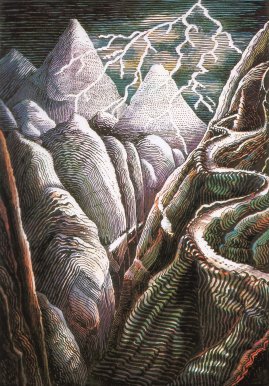 |
Isenmouthe |
Map
showing the Isenmouthe
|
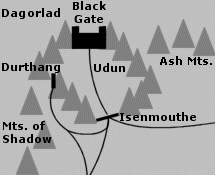 Passage
into Mordor beyond the Black
Gate. The Isenmouthe was located in the valley of Udun
in northwestern Mordor. The Black Gate barred Cirith
Gorgor, the Haunted Pass, at one end of the valley and at the other
end was the Isenmouthe which opened onto the plain of Gorgoroth.
The Isenmouthe was formed by spurs from the Mountains
of Shadow and the Ash Mountains.
Passage
into Mordor beyond the Black
Gate. The Isenmouthe was located in the valley of Udun
in northwestern Mordor. The Black Gate barred Cirith
Gorgor, the Haunted Pass, at one end of the valley and at the other
end was the Isenmouthe which opened onto the plain of Gorgoroth.
The Isenmouthe was formed by spurs from the Mountains
of Shadow and the Ash Mountains.
There were watch-towers and forts on the spurs overlooking the Isenmouthe. Across the narrow passage was a fence of pointed iron posts. There was also an earth-wall and a trench spanned by a single bridge. Roads converged at the Isenmouthe from Barad-dur, Cirith Ungol, and the fortress of Durthang. On the other side of the Isenmouthe, a road led to the Black Gate.
On March 18, 3019 of the Third Age, Frodo Baggins and Sam Gamgee were caught up with a troop of Orcs marching to the Isenmouthe but they managed to escape.
Names &
Etymology:
The name Isenmouthe means
"iron jaws" from the old English word isen meaning "iron" and mouthe
a variant of "mouth." It was named for the fence of iron spikes like teeth.
The Sindarin name was Carach Angren, "iron jaws," from carach
meaning "jaws, rows of teeth" and angren meaning "of iron."
Sources:
The Return
of the King: "The Land of Shadow," p. 197, 205-209; "Mount Doom," p.
210
"Nomenclature
of The Lord of the Rings," entry for Isengard and Isenmouthe
The Silmarillion:
"Appendix - Elements in Quenya and Sindarin Names," entries for anga
and carak
The Lord
of the Rings: A Reader's Companion by Wayne G. Hammond and Christina
Scull: "The Land of Shadow," p. 606-11; "Mount Doom," p. 612
Morgul Pass |
Map
of the Morgul Pass
& the Pass of Cirith Ungol |
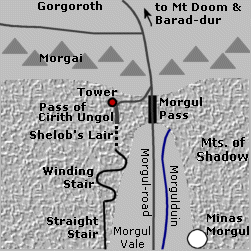 Main
pass from the Morgul Vale into Mordor.
The Morgul Pass was at the far eastern end of the Morgul Vale. The Mountains
of Shadow were relatively low at that point. The Morgul-road
ran through the valley past Minas
Morgul and over the Morgul Pass and then down into Mordor to join a
network of roads crossing Gorgoroth
to Mount Doom and Barad-dur.
Main
pass from the Morgul Vale into Mordor.
The Morgul Pass was at the far eastern end of the Morgul Vale. The Mountains
of Shadow were relatively low at that point. The Morgul-road
ran through the valley past Minas
Morgul and over the Morgul Pass and then down into Mordor to join a
network of roads crossing Gorgoroth
to Mount Doom and Barad-dur.
The Pass of Cirith Ungol was high above the Morgul Pass, on the northern side of the Morgul Vale. In Mordor, the road from Cirith Ungol came down to join the Morgul-road.
Names &
Etymology:
The Morgul Pass was so called
because it was located in the Morgul Vale. The word morgul means
"black magic." The element mor means "black, dark." The element
gûl
means "sorcery, magic" from the stem ngol or nólë
meaning "long study, lore, knowledge."
The pass was also called the Nameless Pass, presumably by those who did not wish to utter the evil name of Morgul.
Sources:
The Two
Towers: "The Black Gate Is Closed," p. 250; "The Stairs of Cirith Ungol,"
p. 319
The Return
of the King: "The Black Gate Opens," p. 161; "The Tower of Cirith Ungol,"
p. 176
Redhorn Gate & Dimrill StairPass over the Misty Mountains. The Redhorn Gate was on the southern slopes of the mountain called the Redhorn, or Caradhras. The pass was high and narrow. For part of the way, a sheer cliff rose on the north side of the pass and a deep ravine lay on the south side. There were no other passes south of the Redhorn Gate until the Misty Mountains ended at the Gap of Rohan.The Dimrill Stair descended from the Redhorn Gate into the Dimrill Dale on the eastern side of the Misty Mountains. It was a steep set of steps cloven into the rocky slopes. A stream called the Dimrill cascaded down the mountainside in a series of waterfalls alongside the Dimrill Stair. In the Second Age, the Redhorn Gate was used for travel between the Elven realms of Eregion and Lothlorien. A broad road ran through Eregion to the mountain pass. But Sauron destroyed Eregion in the year 1697 and over time the road became overgrown. In 2509 of the Third Age, Elrond's wife Celebrian was crossing the Redhorn Gate on her way to Lothlorien when she was captured by Orcs. Although she was rescued by her sons Elladan and Elrohir, she was deeply troubled by what she had endured and she left Middle-earth for the Undying Lands the next year. On January 11-12, 3019, the Fellowship tried to cross the Misty Mountains over the Redhorn Gate. They were caught in a blizzard, and they heard strange voices in the air, and rocks fell down the mountainside at them. Boromir speculated that the storm might be the work of the Enemy, while Gimli thought it was the ill will of the mountain itself. The Fellowship spent the night under the meager shelter of a cliff and the next day they returned the way they had come. Once they descended from the Redhorn Gate, an avalanche blocked the pass completely. The decision was made to cross the Misty Mountains using the underground passages in the Mines of Moria. Other Names:
Sources:
|
The
Redhorn Gate in the New Line film; Digital composite
by Gus Hunter
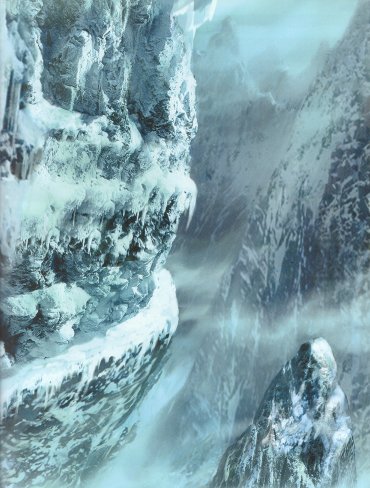 |
Tarlang's Neck |
Map
showing Tarlang's Neck
|
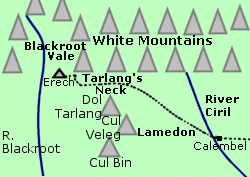 Pass
in the White Mountains. Tarlang's Neck
was located between the main mountain range and a short spur of three mountains
that divided the Blackroot Vale
from Lamedon. The three mountains in the
spur were named Dol Tarlang,
Cul Veleg, and Cul Bin.
Pass
in the White Mountains. Tarlang's Neck
was located between the main mountain range and a short spur of three mountains
that divided the Blackroot Vale
from Lamedon. The three mountains in the
spur were named Dol Tarlang,
Cul Veleg, and Cul Bin.
The road through Tarlang's Neck climbed a long ridge of rock between the main range and the spur. It was a hard and laborious road and it was only used by travellers who were in a hurry.
According to local legend, the White Mountains were originally built by Giants as a means to keep Men out of their land by the Sea. One of the Giants named Tarlang was said to have tripped and broken his neck while he was carrying a heavy load of rocks on his head. His body formed part of the main range while his head and his load of rocks formed the three mountains of the spur: Dol Tarlang - "Tarlang's Head"; Cul Veleg - "big load"; and Cul Bin - "little load." His neck formed the pass and the road ran through the break in his neck.
Aragorn led the Grey Company and the Dead through Tarlang's Neck on the way to Pelargir on March 9, 3019 of the Third Age.
Note:
This local legend appears to be
a "Tall Tale" rather than an actual historical event, though in Middle-earth
one can never be certain!
Names &
Etymology:
The word tarlang means "stiff-necked"
derived from tarch meaning "stiff" and lang or lanc
meaning "neck, throat." Also called Achad Tarlang where achad
is another word for "neck" referring to the vertebrae and not including
the throat.
Sources:
The Return
of the King: "The Passing of the Grey Company," p. 63
The History
of Middle-earth, vol. V, The Lost Road and Other Writings: "The Etymologies,"
entries for LANK and TARAG
"Nomenclature
of The Lord of the Rings," entry for Tarlang's Neck
The Lord
of the Rings: A Reader's Companion by Wayne G. Hammond and Christina
Scull: "The Passing of the Grey Company," p. 536-37
All entries are Copyright © by the Thain from former tuckborough.net. Please contact me if you are Thain or know anything about how to contact the original author.
2003-2011, The Thain's Book - thainsbook.minastirith.cz
- e-mail: thain at tuckborough.net